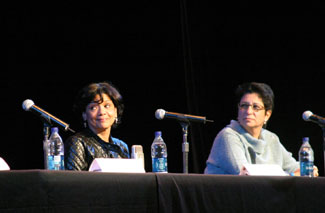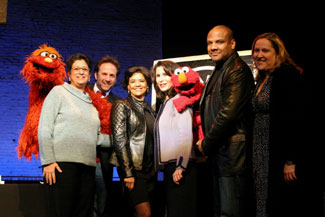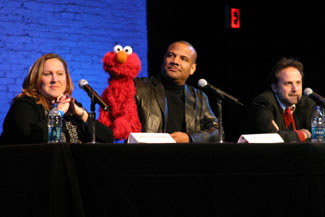
| |||
|
| |||
How to Get to 'Sesame Street' at the Apollo Theater
Presented by the MOFTB, Apollo Theater Foundation, Sesame Workshop, and the Center for Communication, “Sesame Street: Made in NY” provided students and interested New Yorkers with the opportunity to discover the ins and outs of children’s television. When “Sesame Street” premiered on November 10, 1969, it was the first program of its kind. Since then, it has won 118 Emmys and can be seen in 140 countries. Describing the show as a collaboration, head writer Joey Mazzarino noted how the writers work hand in hand with Sesame Workshop’s education department to come up with the best possible script. The challenge for writing “Sesame Street” is to present the material to children so that they don’t realize they’re being taught. According to Dr. Rosemarie Truglio, vice president of education and research, the show is designed to be a preschool classroom for two to five year olds. “The curriculum changes each year.” Dr. Truglio is in charge of the development of the interdisciplinary curriculum, and her team reads through each page of the script to ensure the content is age appropriate. Every piece is tested with children before it’s shot and tested again afterwards. The show strives to make sure they’re teaching their young viewers in the right way. “The original mission in 1969 was to use television to educate children,” said executive producer Carol-Lynn Parente, the first executive producer to grow up watching the show. “That mission hasn’t changed; how we approach the mission has.”  After watching a selection of recent clips from the show, the panelists discussed how they attempt to keep the show culturally relevant. “Sesame Street” continually mines pop culture for funny and educational parodies, like “30 Rocks” or “Word on the Street,” a daily segment designed to increase children’s vocabulary which features a celebrity like Jack Black or Heidi Klum.
After watching a selection of recent clips from the show, the panelists discussed how they attempt to keep the show culturally relevant. “Sesame Street” continually mines pop culture for funny and educational parodies, like “30 Rocks” or “Word on the Street,” a daily segment designed to increase children’s vocabulary which features a celebrity like Jack Black or Heidi Klum.“Little kids do not know Jack Black,” said Mazzarino. “It’s a way to draw in the parents, who will hopefully extend the learning experience.” Senior Puppet Coordinator and Muppet Captain Kevin Clash delighted the audience when he brought out Elmo for a quick hello. In addition to performing as Elmo, Hoots the Owl, and Baby Natasha, Clash directs and serves as a producer on “Sesame Street.” It takes nine months to a year to put together a season from start to finish, Parente explained. Twenty-six episodes are shot each season. Any less, the panelists joked, and they’d have to kick out a letter of the alphabet.  The process starts with meetings between the writers with the education team to determine the curriculum focus. Then the writers meet to discuss ideas and story arcs for the characters. After a review of the previous season, all of the departments get together for production meetings. Each department goes through the script to determine what will be needed in terms of costumes, lights, and sets. The scripts are then shot with the writers on hand to make any last minute revisions. Afterwards, the show goes into post-production, which includes music, scoring and sound mixing. “Sesame Street” is filmed at Kaufman Astoria Studios in Queens, New York.
The process starts with meetings between the writers with the education team to determine the curriculum focus. Then the writers meet to discuss ideas and story arcs for the characters. After a review of the previous season, all of the departments get together for production meetings. Each department goes through the script to determine what will be needed in terms of costumes, lights, and sets. The scripts are then shot with the writers on hand to make any last minute revisions. Afterwards, the show goes into post-production, which includes music, scoring and sound mixing. “Sesame Street” is filmed at Kaufman Astoria Studios in Queens, New York.Sonia Manzano, who hails from the South Bronx, has played Maria since the 1970s. She also wrote for the show for fifteen years. Manzano described how when she started the only girl Muppet on the show was Prairie Dawn. As time went on, female Muppets were slow to make appearances not because the show didn’t want to add them, but because they couldn’t find the performers. “Women didn’t realize they could be puppeteers,” said Manzano. Today’s cast features several female Muppets, including Rosita, Zoe, and Abby Cadabby. The panelists also offered their advice on how to break into children’s television, citing the importance of internships. They also stressed learning about every job on the set. “Being around such talented people, I became a sponge,” said Clash. “I picked up on so many things.” Self-taught in puppetry, Clash suggested that those interested in becoming puppeteers hook up a camera to their TV screen and watch their performance on the screen. “I never knew I could be a writer,” said Mazzarino, who also performs as Murray Monster. “I couldn’t tell a comma from a semicolon. If you have ideas, you can learn the grammar.” All the panelists agreed it’s important to find a job doing something you love. Manzano added that’s it’s also a good idea to try everything. “You don’t know what you’ll like until you try it.” In recent years, the show expanded its presence online with its website (www.sesameworkshop.org) and channels on YouTube and Hulu, offering clips from past seasons. The show is now looking into ways to make its programming more interactive. “‘Sesame Street is a wonderful place to work,” said Parente. “When you work with Elmo and Big Bird, it’s not really work.” | |||
 |
